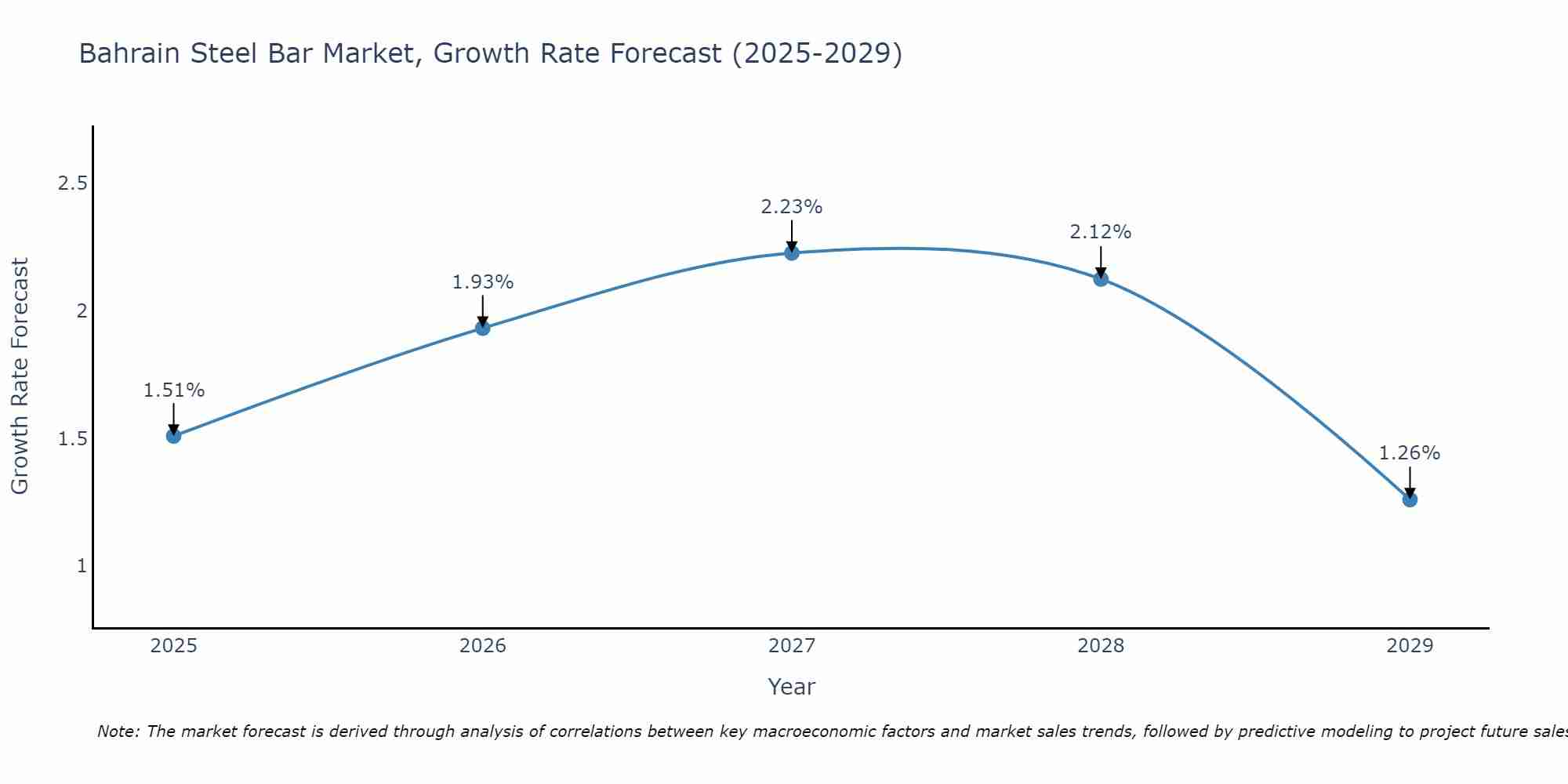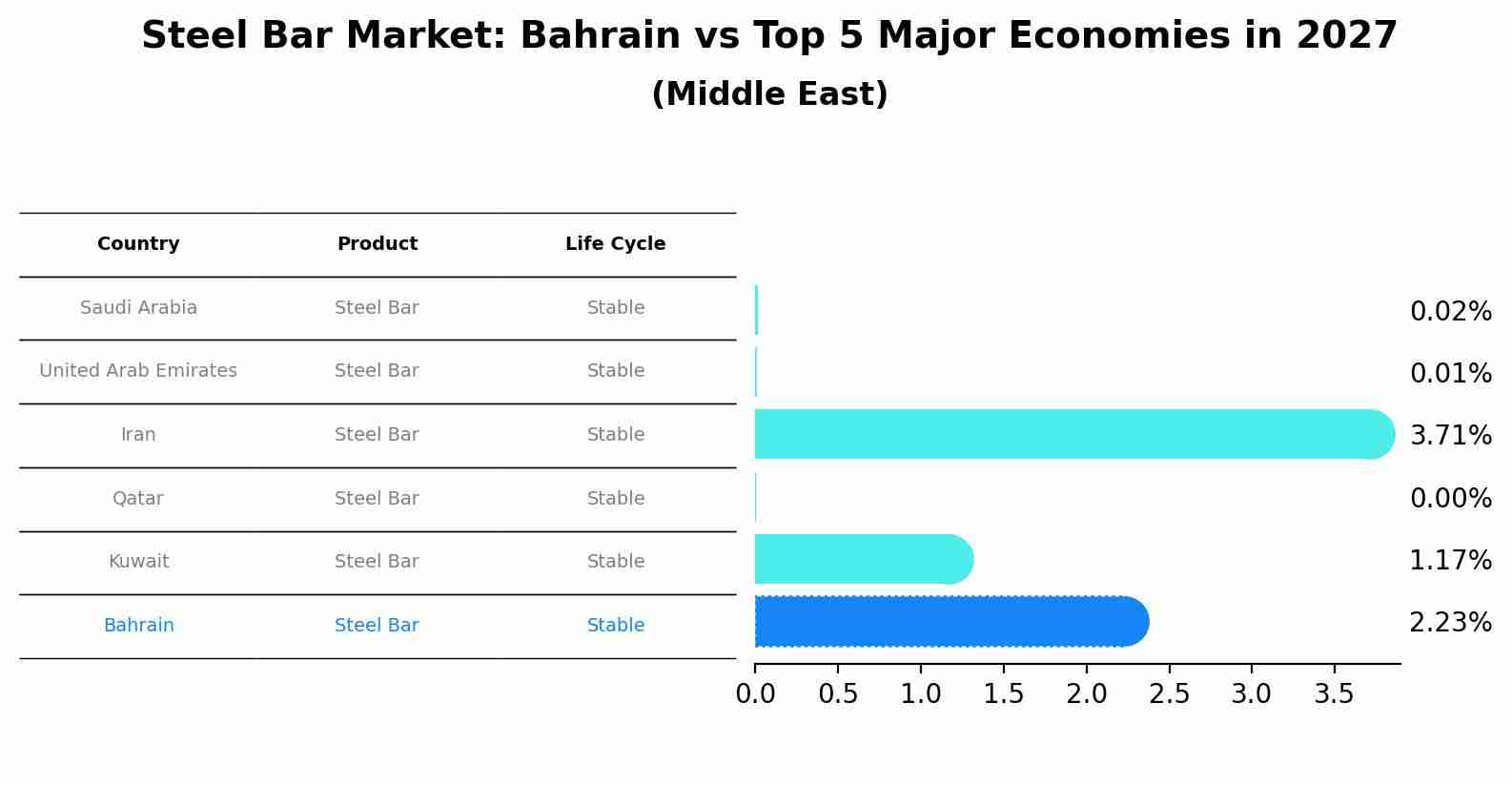Bahrain Steel Bar Market Outlook | Share, Companies, Trends, Analysis, Size, Revenue, Industry, Forecast, COVID-19 IMPACT, Growth & Value
| Product Code: ETC424900 | Publication Date: Oct 2022 | Updated Date: Apr 2025 | Product Type: Market Research Report | |
| Publisher: 6Wresearch | Author: Bhawna Singh | No. of Pages: 75 | No. of Figures: 35 | No. of Tables: 20 |
Bahrain Steel Bar Market Size Growth Rate
The Bahrain Steel Bar Market is projected to witness mixed growth rate patterns during 2025 to 2029. Growth accelerates to 2.23% in 2027, following an initial rate of 1.51%, before easing to 1.26% at the end of the period.

Steel Bar Market: Bahrain vs Top 5 Major Economies in 2027 (Middle East)
The Steel Bar market in Bahrain is projected to grow at a stable growth rate of 2.23% by 2027, highlighting the country's increasing focus on advanced technologies within the Middle East region, where Saudi Arabia holds the dominant position, followed closely by United Arab Emirates, Iran, Qatar and Kuwait, shaping overall regional demand.

Bahrain Steel Bar Market Synopsis
The steel bar market in Bahrain forms a fundamental component of the countrys construction sector. With major infrastructure developments and urban projects underway, there is a consistent demand for reinforced bars, TMT bars, and structural steel. Local manufacturers like SULB play a central role, though the market is also supported by imports from the UAE, India, and Turkey. The growth is largely influenced by government spending on housing and commercial infrastructure.
Trends of the market
Bahrains steel bar market is driven by demand from construction, transportation, and manufacturing industries. Flat bars, round bars, and angle irons are used in everything from scaffolding to machinery. Local rolling mills supply part of the demand, while imports help bridge volume and variety gaps. The market responds to fluctuations in raw material prices, project pipelines, and seasonal construction cycles. Quality certifications and mill test reports are increasingly demanded by contractors and government bodies. Infrastructure development under Bahrain Vision 2030 keeps the market active and competitive.
Challenges of the market
The steel bar market in Bahrain is closely tied to the construction and infrastructure sectors, which are subject to fluctuations in government expenditure and private real estate development. One of the main challenges is the high dependency on imported steel billets for local manufacturing, making pricing vulnerable to global commodity shifts. Additionally, competition from cheaper imports within the GCC creates pressure on local producers to maintain both quality and cost-effectiveness. Inconsistent demand cycles, especially during economic downturns or construction delays, can affect inventory planning and lead to financial strain. Another challenge is ensuring compliance with international building standards, as substandard steel bars can compromise structural integrity and erode customer trust.
Investment opportunities in the Market
The steel bar market in Bahrain continues to benefit from expanding construction, oil & gas, and transportation sectors. Investors can tap into this robust demand by establishing rolling mills, engaging in raw material imports, or entering into EPC (engineering, procurement, and construction) alliances to ensure a steady supply to key projects. The demand for custom steel bar grades, anti-corrosive coatings, and quality certifications is rising, making technical excellence and logistics integration key value drivers. Bahrains strategic location enables suppliers to serve not only domestic but also regional GCC markets efficiently.
Government Policy of the market
The Bahrain steel bar market is shaped by policies that prioritize both local production and international trade. The government regulates the quality of steel bars used in construction and manufacturing through stringent standards that align with international best practices. Bahrains industrial policies encourage the establishment of steel production plants by offering incentives, including favorable tax rates and infrastructure support. As the construction sector grows, particularly with new development projects in real estate and infrastructure, demand for steel bars continues to increase. Bahrains strategic location and access to major regional markets enhance the competitiveness of the steel bar industry in the GCC, and government initiatives are focused on increasing exports.
Key Highlights of the Report:
- Bahrain Steel Bar Market Outlook
- Market Size of Bahrain Steel Bar Market, 2021
- Forecast of Bahrain Steel Bar Market, 2031
- Historical Data and Forecast of Bahrain Steel Bar Revenues & Volume for the Period 2018 - 2031
- Bahrain Steel Bar Market Trend Evolution
- Bahrain Steel Bar Market Drivers and Challenges
- Bahrain Steel Bar Price Trends
- Bahrain Steel Bar Porter's Five Forces
- Bahrain Steel Bar Industry Life Cycle
- Historical Data and Forecast of Bahrain Steel Bar Market Revenues & Volume By Product Type for the Period 2018 - 2031
- Historical Data and Forecast of Bahrain Steel Bar Market Revenues & Volume By Deformed Steel Bar for the Period 2018 - 2031
- Historical Data and Forecast of Bahrain Steel Bar Market Revenues & Volume By Mild Steel Bar for the Period 2018 - 2031
- Historical Data and Forecast of Bahrain Steel Bar Market Revenues & Volume By Application for the Period 2018 - 2031
- Historical Data and Forecast of Bahrain Steel Bar Market Revenues & Volume By Infrastructure for the Period 2018 - 2031
- Historical Data and Forecast of Bahrain Steel Bar Market Revenues & Volume By Building for the Period 2018 - 2031
- Historical Data and Forecast of Bahrain Steel Bar Market Revenues & Volume By Industrial for the Period 2018 - 2031
- Bahrain Steel Bar Import Export Trade Statistics
- Market Opportunity Assessment By Product Type
- Market Opportunity Assessment By Application
- Bahrain Steel Bar Top Companies Market Share
- Bahrain Steel Bar Competitive Benchmarking By Technical and Operational Parameters
- Bahrain Steel Bar Company Profiles
- Bahrain Steel Bar Key Strategic Recommendations
Frequently Asked Questions About the Market Study (FAQs):
1 Executive Summary |
2 Introduction |
2.1 Key Highlights of the Report |
2.2 Report Description |
2.3 Market Scope & Segmentation |
2.4 Research Methodology |
2.5 Assumptions |
3 Bahrain Steel Bar Market Overview |
3.1 Bahrain Country Macro Economic Indicators |
3.2 Bahrain Steel Bar Market Revenues & Volume, 2021 & 2031F |
3.3 Bahrain Steel Bar Market - Industry Life Cycle |
3.4 Bahrain Steel Bar Market - Porter's Five Forces |
3.5 Bahrain Steel Bar Market Revenues & Volume Share, By Product Type, 2021 & 2031F |
3.6 Bahrain Steel Bar Market Revenues & Volume Share, By Application, 2021 & 2031F |
4 Bahrain Steel Bar Market Dynamics |
4.1 Impact Analysis |
4.2 Market Drivers |
4.3 Market Restraints |
5 Bahrain Steel Bar Market Trends |
6 Bahrain Steel Bar Market, By Types |
6.1 Bahrain Steel Bar Market, By Product Type |
6.1.1 Overview and Analysis |
6.1.2 Bahrain Steel Bar Market Revenues & Volume, By Product Type, 2018 - 2031F |
6.1.3 Bahrain Steel Bar Market Revenues & Volume, By Deformed Steel Bar, 2018 - 2031F |
6.1.4 Bahrain Steel Bar Market Revenues & Volume, By Mild Steel Bar, 2018 - 2031F |
6.2 Bahrain Steel Bar Market, By Application |
6.2.1 Overview and Analysis |
6.2.2 Bahrain Steel Bar Market Revenues & Volume, By Infrastructure, 2018 - 2031F |
6.2.3 Bahrain Steel Bar Market Revenues & Volume, By Building, 2018 - 2031F |
6.2.4 Bahrain Steel Bar Market Revenues & Volume, By Industrial, 2018 - 2031F |
7 Bahrain Steel Bar Market Import-Export Trade Statistics |
7.1 Bahrain Steel Bar Market Export to Major Countries |
7.2 Bahrain Steel Bar Market Imports from Major Countries |
8 Bahrain Steel Bar Market Key Performance Indicators |
9 Bahrain Steel Bar Market - Opportunity Assessment |
9.1 Bahrain Steel Bar Market Opportunity Assessment, By Product Type, 2021 & 2031F |
9.2 Bahrain Steel Bar Market Opportunity Assessment, By Application, 2021 & 2031F |
10 Bahrain Steel Bar Market - Competitive Landscape |
10.1 Bahrain Steel Bar Market Revenue Share, By Companies, 2021 |
10.2 Bahrain Steel Bar Market Competitive Benchmarking, By Operating and Technical Parameters |
11 Company Profiles |
12 Recommendations |
13 Disclaimer |
- Single User License$ 1,995
- Department License$ 2,400
- Site License$ 3,120
- Global License$ 3,795
Search
Related Reports
- Middle East OLED Market (2025-2031) | Outlook, Forecast, Revenue, Growth, Companies, Analysis, Industry, Share, Trends, Value & Size
- Taiwan Electric Truck Market (2025-2031) | Outlook, Industry, Revenue, Size, Forecast, Growth, Analysis, Share, Companies, Value & Trends
- South Korea Electric Bus Market (2025-2031) | Outlook, Industry, Companies, Analysis, Size, Revenue, Value, Forecast, Trends, Growth & Share
- Vietnam Electric Vehicle Charging Infrastructure Market (2025-2031) | Outlook, Analysis, Forecast, Trends, Growth, Share, Industry, Companies, Size, Value & Revenue
- Vietnam Meat Market (2025-2031) | Companies, Industry, Forecast, Value, Trends, Analysis, Share, Growth, Revenue, Size & Outlook
- Vietnam Spices Market (2025-2031) | Companies, Revenue, Share, Value, Growth, Trends, Industry, Forecast, Outlook, Size & Analysis
- Iran Portable Fire Extinguisher Market (2025-2031) | Value, Forecast, Companies, Industry, Analysis, Trends, Growth, Revenue, Size & Share
- Philippines Animal Feed Market (2025-2031) | Companies, industry, Size, Share, Revenue, Analysis, Forecast, Growth, Outlook
- India Lingerie Market (2025-2031) | Companies, Growth, Forecast, Outlook, Size, Value, Revenue, Share, Trends, Analysis & Industry
- India Smoke Detector Market (2025-2031) | Trends, Share, Analysis, Revenue, Companies, Industry, Forecast, Size, Growth & Value
Industry Events and Analyst Meet
Our Clients
Whitepaper
- Middle East & Africa Commercial Security Market Click here to view more.
- Middle East & Africa Fire Safety Systems & Equipment Market Click here to view more.
- GCC Drone Market Click here to view more.
- Middle East Lighting Fixture Market Click here to view more.
- GCC Physical & Perimeter Security Market Click here to view more.
6WResearch In News
- Doha a strategic location for EV manufacturing hub: IPA Qatar
- Demand for luxury TVs surging in the GCC, says Samsung
- Empowering Growth: The Thriving Journey of Bangladesh’s Cable Industry
- Demand for luxury TVs surging in the GCC, says Samsung
- Video call with a traditional healer? Once unthinkable, it’s now common in South Africa
- Intelligent Buildings To Smooth GCC’s Path To Net Zero













